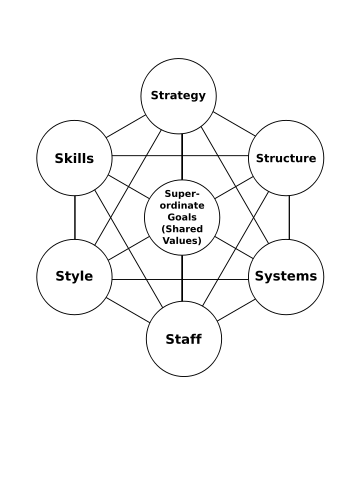The McKinsey 7 S framework or model for strategic fit was developed over thirty years ago by strategy consultants McKinsey and in particular Tom Peters and Robert Waterman, co-authors of the classic book “In Search of Excellence” to help implement strategies.
What Is The McKinsey 7 S Framework?
It was originally thought that to implement strategy you needed to align strategy with structure (and vice-versa).
This wasn’t enough and McKinsey developed the 7-S model to show that a softer set of issues also needed to be considered when implementing strategy.
The 7 S’s are:
- Strategy – how the business intends to create a competitive advantage and achieve its overall goals.
. - Structure – the hierarchy of responsibility and accountability within the organisation and how the business is organised functionally, geographically or by product-market.
. - Systems – the way activities and processes get the work of the business done effectively and efficiently.
. - Style – the culture of the business and the way the leaders behave towards customers, employees and other stakeholders. What’s said is much less important than what’s done.
. - Staff – the personnel within the business and their individual skills, abilities and attitudes. Different people are right for different organisations.
. - Skills – specialist skills that the business has access to through the combination of systems and staff – think core competences or distinctive capabilities.
. - Shared values or subordinate goals depending on which version you read – the core values and beliefs of the business.
The “hard elements” are strategy, structure and systems.
The “soft elements” are style, staff, skills and shared values.
The idea is that all these seven elements are interlinked and you need to consider how any changes impact on and can be impacted by the other elements of the McKinsey 7 s framework.
Personally I’d have liked explicit focus on the role of performance measures (it could fit into the 7-S alliteration as Scorecard) because I believe “what gets measured gets done.” Techniques like the Balanced Scorecard are important additional strategy implementation tools.
The Classic McKinsey 7 S Framework Diagram
As well as being an important contribution to the “implementation gap” and a clever alliteration, the 7-S’ model also had this neat diagram. Notice that all the S’s are connected but the Subordinate Goals or Shared Values are what bind the organisation together.

How To Use The McKinsey 7 S Framework
You’ll find the 7S framework more useful for asking the right questions than coming up with the answers but that’s a great start in a strategic change programme.
The 7S model is very flexible and you can use it in several ways.
First, if there is a performance issue where things aren’t as they should be, you can use the 7 S framework as a diagnostic tool.
The problems lie in some kind of inconsistency between the 7 S’s.
If the strategy is right, then perhaps the problem lies in the structure of the business or in its systems. Or perhaps its at odds with the core shared values of the business or the personal style of the owner or CEO.
Second, if you’re implementing strategic change you can audit the organisation through the 7 S framework in terms of “as-is” and then think through your strategy and how the 7 S model should be.
This will highlight differences which need to be resolved. it may even be that the strategy you want to implement is out of reach for the business as it is and you need to make smaller incremental steps.
The third way to use the McKinsey 7 S framework is to look back at a strategic change that hasn’t worked as well as expected and to look for gaps or overlooked areas in the implementation plan through the lens of the 7 S model. While it’s too late, it is a powerful learning exercise when you appreciate how one factor can stop a strategy from working.
Criticism Of The McKinsey 7S Framework
The 7 S model is about achieving strategic fit across the organisation. Richard D’Aveni in his book Hypercompetition argues that this consistency makes the business predictable and therefore easier for a competitor following an aggressive strategy to anticipate and beat.
It’s an interesting idea and a case of “your strength becomes your weakness”. With the 7 S Model, your chances of implementing strategy increase but competitors can guess what you’re trying to do. Without the consistency embedded in the 7 S model, the strategy has little chance to be turned from a plan into reality.
Richard D’Aveni developed a New 7 S Model to compete effectively in hyper-competitive markets.
Models Like The 7-S Are Important
While using a model like the McKinsey 7 S framework can seem cumbersome, it is a very useful aide-memoire to make sure that you’re not overlooking an important issue and it’s helpful to focus discussions on implementation issues and to bring assumptions and unsaid expectations to the surface.
The McKinsey 7-S Framework is included in my summary of Strategic Planning Models.
Have You Used the McKinsey 7 S Model?
If you’ve used the McKinsey 7 S model I’d like to know how you found it.
Did it help you to succeed or focus on strategy implementation issues that you may have otherwise overlooked?





